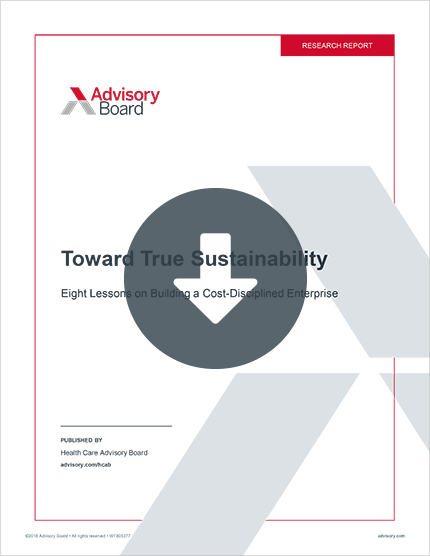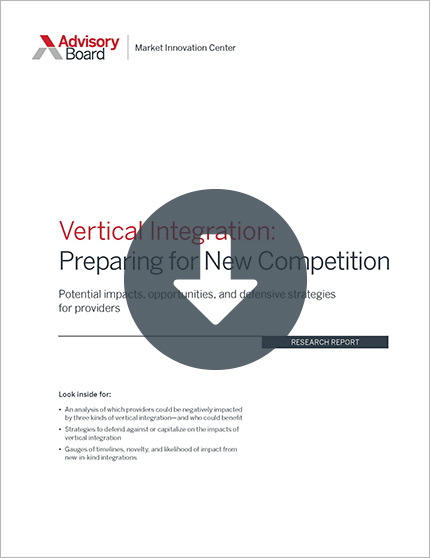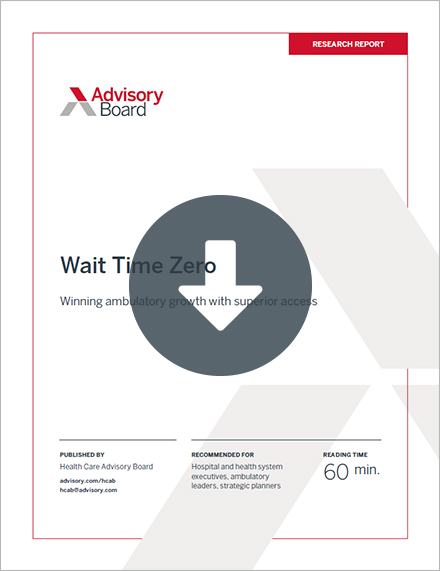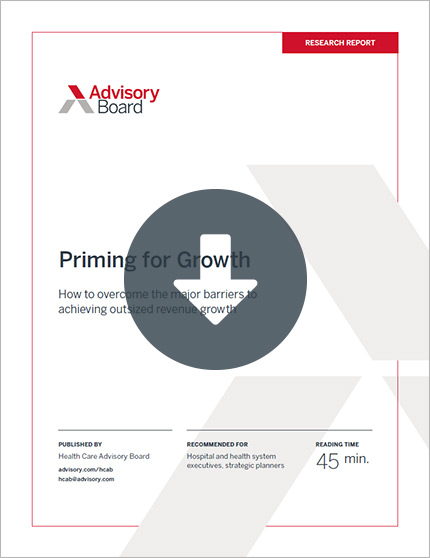Auto logout in seconds.
Continue LogoutWelcome to the "Lessons from the C-suite" series, featuring Advisory Board President Eric Larsen's conversations with the most influential leaders in health care.
In this edition, Peter Fine, CEO of Banner Health, talks with Eric and Robert Musslewhite, CEO of OptumInsight, about surrounding yourself with disruptors, channeling JFK when approaching competitors, and utilizing "wise guides" to build trust.
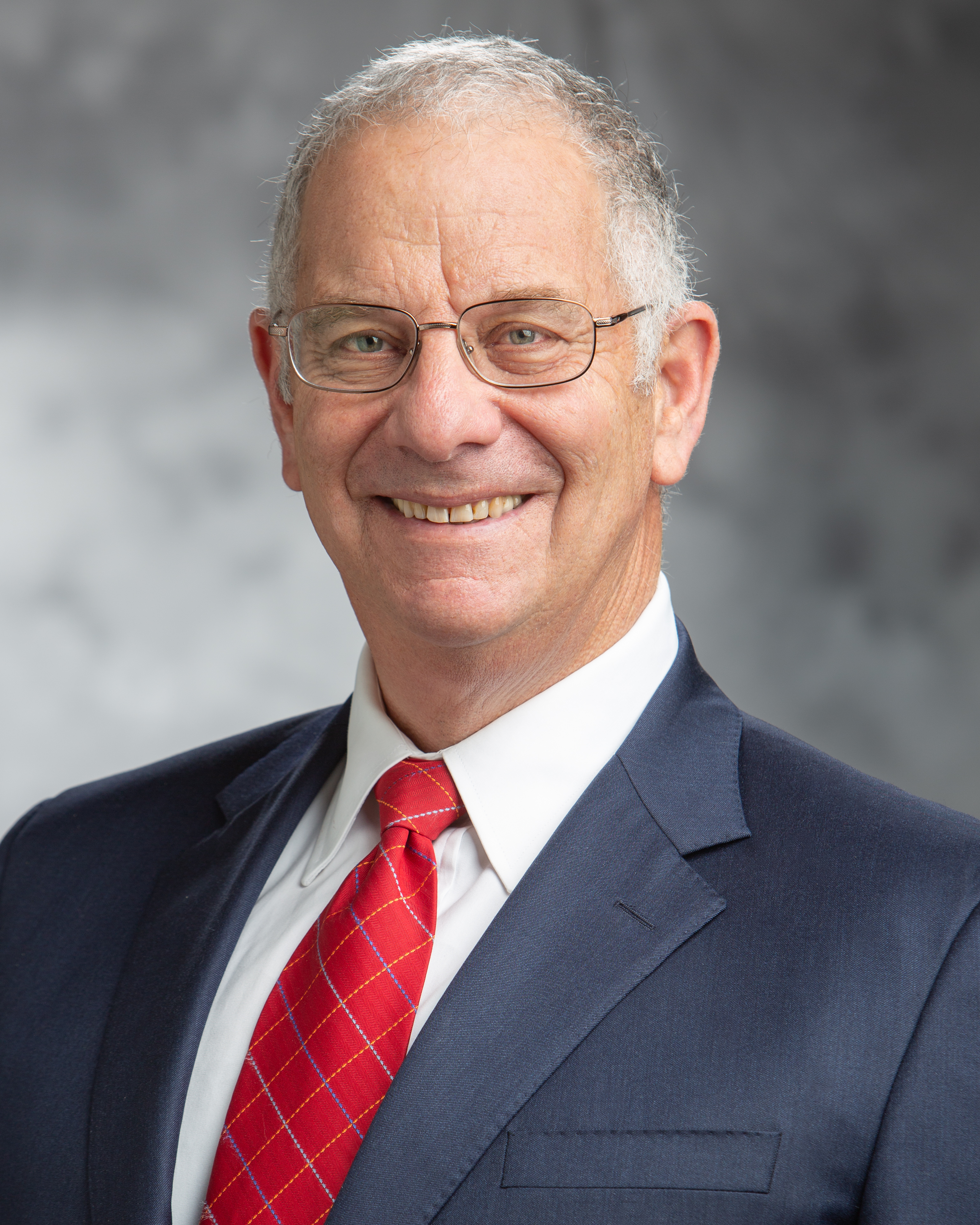
Peter Fine, CEO of Banner Health
Question: Peter, let's start with a milestone that you just passed in November, which is your 20th anniversary with Banner. You're one of the longest tenured health system CEOs in the country. Pretty remarkable.
Peter Fine: Thank you, Eric and Robert. I think what has allowed me to lead for 20 years is that the business model of Banner has morphed multiple times. We're not anything like the company that I joined 20 years ago, which has done a couple of things. It's kept it interesting, and that's important, because you can get a little bit lazy with the running of a company. And I have had the ability to work with a board that is very forward-thinking. A lot of nonprofit health systems recruit local board members because they're reputable in the community. In our case, we go with content expertise. I had a conversation recently with a consultant, and he said to me, "I've worked with a lot of systems in this country, and you have the most corporate board in a nonprofit environment I've ever seen."
Q: Let's unpack that, because you've been able to overcome one of the impediments that many growth-oriented health systems face—the localism and the parochialism of the board. Instead, Peter, you've intentionally assembled a competency and domain expertise-based board.
Peter: It's a very deliberate decision, Eric. For example, I think you must bring into the board room people from companies that deal with the front door of the consumer. We have a board member who's the chief strategy officer for Cox Communications. She was recruited because the cable industry is being disrupted. She brings incredible insight into modifying your company's strategy in a disruptive environment. And they're also an industry that deals with direct-to-consumer marketing.
The 2021 playbook webinar series
Jan. 28
What the future holds for primary care
Another thing we have understand is demographic changes. Over the next decade, the biggest demographic change in Arizona is going to be within the Hispanic population. We wanted someone on the board to help us understand how to market to and serve a multicultural population. So we recruited the former vice president of multicultural marketing at Disney, Procter & Gamble, and Coca-Cola, who also happens to be Hispanic, to give us insight into the changing nature of Hispanic consumers.
And then a third one is clearly the challenge of marrying the financing of care with the delivery of care. So we have the former CEO of Blue Cross of Colorado to give us insight as we have grown from virtually no at-risk premium business to $2 billion and growing.
Q: How do you harness that high-powered insight in a board setting? Do you encourage them to challenge, even contradict, your thinking openly? Interact directly with your senior team outside of board sessions? I'd be curious to hear some of your best practices here.
Peter: All of the above, Robert. Let me give a historical perspective and then I'll work you up to where the thinking is today. When I got hired, I said to the board, "There are two things that are absolute for me. One is I'm going to give you unfettered access to my leadership team. But they're going to tell me what you call them about, what the discussion was, and what they told you." The second thing I said was, "I have to be able to say anything I need to say to you within the board meeting, and you have every right to push hard on me." Easy to say, hard to do. You have to build trust.
At my first board meeting, one board member just went on and on and on. And my management team said to me, "Why did you let him do that? He was showing off." I said, "Listen, I could have interrupted him anytime I wanted to, because he perceived himself as a content expert and he wasn't. But I'm trying to build trust with the board and having them feel comfortable they can say whatever they want to say, because that gives me the ability to say whatever I want to say."
And so that philosophy, that trust, has been built over 20 years. In the confines of a board room, any board member, even with my management team there, feels comfortable in saying whatever they want to say. And I can disagree with them nicely and tactfully in front of the rest of the board, which I've done numerous times. It's created an environment of trust between governance and management.
And so, now, as we have these content experts, they serve two purposes. One is putting issues on the table to allow the board to be better educated about an issue that lies within their area of expertise. And two, it allows me to tap into that expertise. So, this former vice president of multicultural marketing for Disney, he's been consulting with our internal marketing and communication teams on how we position ourselves for a growing middle-class Hispanic population and how do we become the go-to organization for the Hispanic market. That's been a huge advantage to tap into that knowledge set.
Q: That resonates. You chose executives specifically from industries that themselves were at risk of disruption, or who had successfully tackled specific challenges you were facing.
Peter: Yes, exactly. And we also have a health care system CEO, who ran his system for ten years and was CMO there for 10 years before that. I recruited him because I wanted the knowledge base that he brought of an organization that had morphed and changed through M&A. But he also is here because, I’m 20 years in and I’m 68 now. I don't have another 20 years to go. I wanted somebody on the board who had gone through a successful process of replacing himself.
I'm not ready to retire yet, though. I find disruption to be fascinating. There's a tendency for some organizations to be risk averse right now. I actually think just the opposite. Disruption is an opportunity to take more risk and be more innovative. And we have a board that supports that.
So I've segregated a small component of the organization and told them, "Your job is to think about the future. I don't want you thinking about the pandemic at all. We have other people to deal with the issues of PPE and intensive care beds and ventilators." I want them thinking about how we can take advantage of what's going on and be opportunistic and reposition ourselves for growth coming out of the pandemic.
The race to consolidation in health care
Q: Peter, let's turn to industry M&A for a moment. Obviously, pre-pandemic there was a frenzy of horizontal M&A among health systems. In fact, coming into the pandemic, the top 92 nonprofits and the eight largest private equity-backed and publicly traded hospital companies collectively controlled $856 billion out of the $1.2 trillion health system sector. So just a ton of consolidation, and of course you and Banner have played an active role in this—Banner is now a nearly $10-billion system, with 31 hospitals across seven states.
What is your prediction for health system consolidation post-pandemic? On the one hand, the consequences of 2020 for some will exacerbate pre-existing financial and strategic vulnerabilities and stimulate a move to consolidate with stronger players. On the other hand, there are headwinds: announced and then discarded mergers such as Intermountain/Sanford or Memorial Hermann/Baylor Scott & White, as well as increased regulatory scrutiny from a muscled-up FTC and the likely appointment of Xavier Becerra to HHS.
Peter: Yes, fair assessment. I think about it like this, Eric: There are already enormous players in our industry, including CVS/Aetna, UHG/Optum, and others, and these organizations are migrating into the caregiving side and cherry-picking the things that they can make money on. [Editor's note: The Daily Briefing is published by Advisory Board, a division of Optum, which is a wholly owned subsidiary of UnitedHealth Group.] That creates disruption. And it forces the rest of us to think about our relevancy.
You're never going to see a hospital system as big as Optum, Eric and Robert, as you guys both know. But I don't think you have to be that big to have relevancy. Relevancy for nonprofits has typically been defined in terms of local geography. But now, I think you're seeing an orientation toward national relevancy. How do you get relevant nationally? How do you get so important that people have to listen to you?
HCA is a $51 billion company and it's going to get much bigger. It’s definitely relevant. And you have the big holding companies, which many of the Catholic systems seem to be. But it's hard to find big relevant secular nonprofits. I think that's the next stage. That's what Advocate/Aurora was about when it was created. Nick Turkal and Jim Skogsbergh made the decision that scale is strategy. I think you're going to end up with some big $40 to $50 billion systems in the nonprofit sector. And because of our thinking about the creation of a large relevant secular nonprofit we continue to look for opportunities to expand our organization and are focused on expanding our ambulatory product lines. At a recent board meeting, we authorized a $240 million project to increase our assets on our Banner MD Anderson campus. This partnership with MD Anderson has been quite successful—over the last 10 years, we’ve built satellite campuses around the Phoenix marketplace. So we're expanding our reach, which is giving us a big advantage. But all that said, we're not nearly big enough to have national relevancy like HCA or many of the large Catholic systems.
So I think consolidation is going to become quite significant over the next five years because of the issue of relevancy and the pressures on us from the federal government and other places. But deals can blow up for reasons that you just don't predict, as you mentioned Eric.
Q: Peter, from this conversation it sounds like Banner is receptive to a potential noncontiguous merger, especially with the preparation you've done on the governance front. I hear optimism in your voice that one of these megadeals could work for Banner. Still, as we've just pointed out, a lot of these noncontiguous mergers have fallen apart. What gives you confidence on this front?
Peter: You have to ask the question, what is the value of a noncontiguous merger as opposed to a contiguous merger. I don't think a contiguous merger matters that much. It's about how you run the business, and it's about how focused you are on an operating model. HCA has an operating model. It doesn't have contiguous locations. Kaiser has an operating model. It doesn't have contiguous locations. I don't think you need a next-door neighbor as much as you need a strong operating model and a partner with a similar culture.
If you can operate a noncontiguous merger not like a holding company but like an operating company—and are committed to doing that—you can create a pretty big behemoth. And you have to set your egos aside, and you have to have board members who can think the right way, and you have to have CEOs that are the right age. If you try to put a merger together with two CEOs and they're 52 years old, good luck. That's not happening. But a merger together with a CEO who's 68 and another company with a 52-year-old CEO, that’s a marriage that can work.
Q: You mentioned the strategic advantages that come from being an operating company. And Banner has been an exemplar here: While some of the larger, multi-state, nonprofit systems are perhaps best categorized as holding companies, Banner has earned a reputation as a disciplined operator, and an innovator in reducing unwarranted clinical variation. You don't shy away from this identity, Peter, and have even used the terminology of industrial engineering as you built out your operating structure. So this is clearly a competitive strength as you've grown.
A second area of potential strategic M&A advantage is in vertical integration and taking on more premium-dollar risk. I was struck by a comment you made earlier that Banner has $2 billion under these type of capitated arrangements already.
So as Banner thinks about future M&A, I assume both of these priorities—extraction of operating synergies and further vertical integration—are top of mind. Fair characterization?
Peter: Yes, definitely a fair characterization. It certainly doesn't have to be either/or. We're in a commercial growth market here in Arizona. But we also have a large component of federal business that we must learn how to manage. And risk is actually a very big and growing piece of the company right now. This year, even with Covid-19, as you pointed out, we will have $2 billion of insurance and at-risk premium dollars. Twenty years ago, it was zero. If I look at other options with other organizations, clearly, we want partners that have the same view we have about managing lives and needing to be in the at-risk environment. There are some very good organizations that don't necessarily share a similar view of the future. We want to have cultural fit from that perspective, and we think that's the key to becoming a $20, $30, $40 billion organization.
Q: Can you disaggregate that $2 billion for us? Are you talking full capitation? Full premium dollar?
Peter: It has multiple parts to it. We own a Medicaid insurance company that has about 250,000 enrollees. It might only make 1% or 2%, but there's a lot of revenue flowing through it. We also have delegated risk from United and Humana that represents about 123,000 enrollees. And we have a third piece, our Banner-branded Medicare Advantage plan. It is in the market now. We're going to grow slowly in the first few years until we have a four-star rating. Once we get our four-star rating, we'll take the extra money and invest it in growing the product.
And then the fourth area, we own 49% of Aetna's commercial insurance business in Arizona representing approximately 348,000 lives. We are about ready to buy that extra 1% and we'll have a 50-50 ownership of that. And in the fifth area, we have various Medicare Advantage and MSSP programs representing 132,000 covered lives. So, those components of delegated business, Medicare Advantage, our Medicaid insurance company, and our commercial insurance company joint venture with Aetna representing approximately 936,000 lives, ends up being a lot of revenue, more than you might think.
As to why we’re doing vertical integration, we decided we couldn't exist long term just being a well-run hospital company. We've built a different business. We've got an urgent care business that has around 49 sites. We have more room to grow there. We have an imaging company with 23 sites. We have a surgery center company with 10 locations. And we have a joint venture with Select Medical, in which we now have 40 sites for physical therapy. We're the largest physical therapy rehab site in the state right now and growing. Plus, we've built two rehab hospitals that have opened now and a third one that is being built down in the East Valley, next to our MD Anderson Cancer Center. And in all of these ambulatory businesses, we continue to look for new sites and locations.
With this vertical integration we can keep people within our own products as they move through the system of care. And now we have coupled that with the financing arm. This has allowed us to more closely align with the customer both from a financing perspective and from a care perspective.
Q: So let me take a pass at summarizing, Peter. You've built an "ambulatory perimeter" with your partnerships in ASCs, rehab, and urgent care. Then you're vertically integrating on the finance side so you can arbitrage down medical loss ratio. In other words, you are "self-commoditizing" your higher-acuity, tertiary, and quaternary. Expensive assets—but you're doing it to yourself so someone else doesn't externally do it to you. And underneath all of that is the advantage of your operational discipline.
And if this is a fair summary, I wonder: Did the very virtue of your pre-pandemic operational and financial discipline add a different kind of complexity during the pandemic versus other health systems who perhaps weren't as rigorous as Banner on the operating side? In other words, did your leanness and "just-in-time" efficiency (versus a "just-in-case" level of reserves) present unique challenges for Banner during the pandemic?
Peter: Yes, fair summary. And it's an interesting question, Eric. Overall I look at Banner as a something of a "for-profit with a heart," and I use that term periodically, as a recognition that we have to run this business with the structure and the discipline that you would typically see in many for-profit businesses. But the heart piece is that we have certain obligations. For example, we run a poison control center for the state. We don't make any money doing that, because we don't charge anything for it. It's just something that we do and we've been thinking about contracting that out to other states because we run it so well.
During the pandemic our model has worked very well for us, because we have been able to move resources around where resources needed to be. We can move patients around. We can move employees around. And we have done that. We've shipped employees up to Colorado while Colorado has shipped employees down here. We have a giant warehouse that serves all our assets in Arizona. We can buy in bulk, which gives us pricing advantage, and then we can distribute locally on our own. And that's given us just some huge advantages on being able to stockpile a product and then distribute locally so we don't have to be concerned with the limitations that suppliers and distributors have had to implement.
Another way it has helped us is our perception in the labor market. When we've needed to tap into external agencies, the feedback these agencies were getting from their people that they sent to us was, "Wow, that is a good organization to work with. Going in there as an agency nurse wasn't very difficult. Their orientation process was very well done." We're very optimistic about our ability to handle future surges because people want to work with us.
Post-pandemic structural shifts
Q: Let's turn our lens to a post-pandemic world. In your estimation, Peter, what are some of the big structural shifts in health care that are going to endure past the end of the pandemic?
Peter: How we relate to physicians for one thing. The manner in which we have handled ourselves in this pandemic has caused a lot of physicians to look to us who weren't looking to us before. Physicians want to be with organizations that have long-term stability and long-term sustainability.
And the consumer. One of the things we're recognizing is that we had component parts we should take more advantage of. We were a little bit hesitant in doing direct-to-the-consumer marketing. Once we get somebody into the ecosystem, we're keeping them for a long time. And so now we're focusing more on getting them into this ecosystem. We knew we needed to have way more access points, that's another thing that is showing up through this year, in the pandemic. The fact that we started growing our access points gives us a greater capability to make health care made easier, so life can be better, which is our mission statement.
We started down that path in 2017. Prior to that, we thought it was all about clinical expertise, which was our one-sentence mission statement from before I got to Banner. But we began to recognize that the consumer's changing. And the consumer sees clinical expertise as a given, that's a starting point, and we had to reorient our thinking around health care easier, so life could be better. And that's played out very well for us, because the whole organizational structure has been looking to identify where there have been roadblocks to making health care easier.
The things we have been doing structurally have been really critical this year. For example, we’ve spent $50 million on our digital efforts. We created video and teleconferencing with patients that they can do right from our website. And then the pandemic happens, and this becomes even more important.
My own primary care doctor said to me back in May that 60% of his visits had moved to video and teleconference. Now a portion of those patients he had to bring in anyhow, just because of the complexity of their care. But this whole movement towards making it easier for patients to interact with us, now we're seeing that play out in basically creating new products for customers, and it's working. We can see it by the volumes of people that are accessing our website through these various means. So it's grown our market share for sure.
Q: And that's obviously a hugely consequential change. What else falls into that category of making health care easier and life better? If I'm a consumer in your market, what will be different for me about Banner?
Peter: So one of the things we saw early in the pandemic was that people weren't sure who they could trust. We made a decision in the early spring that we were going to position ourselves as the wise guide, not wise guy. And we asked Marjorie Bessel, our chief clinical officer, to be our voice to the public. We asked her to challenge the governor, challenge the president, and be that "wise guide." And that led to an increasing level of trust in Banner, and it is amazing to watch how the numbers demonstrate that.
We created drive-thru testing sites. We took our urgent cares and positioned them to be places that Covid-19 patients could come and get tested. So the push towards convenience, the purposeful positioning of ourselves and our chief clinical officer as the trusted source that people could go to, that's going to play out for years. People looking to Banner and saying, "Well, that's the organization I have to be with because I trust them."
So the idea of health care made easier and life made better has become the mantra of the organization. Everything we do, whether it's the investment of resources, the creation of products, or the way people access us, that mantra has filtered into all of the decisions that we're making. Covid-19 has actually allowed us to move even faster, especially in the ambulatory environment to change the way we were accessed.
Q: Peter, I'm struck by how the theme of disruption has pervaded our entire conversation. It goes back to what you first said about being intentional about recruiting board members and senior staff that have that domain expertise Banner needs, and specifically drawing these leaders from "disruptor" organizations. Essentially choosing experts from industries that were themselves at risk of disruption, disintermediation, commodification—and applying their insights to Banner.
But now some of these external industry players are themselves invading our space—retailers, trillion-dollar fintech companies, private-equity backed pure-play companies, you name it. And these non-traditional competitors are well-capitalized, aggressive, and unburdened by the fixed costs of tertiary and quaternary care. Sometimes it's the retailers like Wal-Mart or Walgreens, other times it's private equity-backed or publicly-traded "pure plays" like One Medical or Oak Street. How do you think about these non-traditional disruptors?
Peter: We classify them as PT boats. That's what John Kennedy was on before he got blown out of the water when he was in the war. Fast-paced, quick-moving, well-financed, and very targeted in a segment that they're going after. In the last few years, we've had to say to ourselves, how are we going to change our culture to compete with that? One thing is that our decision-making today is significantly faster than it was five years ago. We're now forcing things, and I've had to move people out and bring people in that could think differently and can recognize that speed to market is important.
So we can move more nimbly now, like a PT boat, but we have the assets and capabilities of a destroyer too. Don't forget how big our frontline is. Banner Medical Group is a monster. No offense to One Medical, I think they have three locations in our market, but I have ten times the access points One Medical has through our own Banner Medical Group and then through the Banner Health Network.
Oak Street Health, that's a bigger risk. I see why they have a $14 billion market capitalization. We're building our own comparable sites that are Medicare-only products from a primary care perspective, because that is a good product. That's where we think the real money is. But with private equity, you know, at the end of the day, you have to make money on these things. I was talking to a dermatologist recently, who is part of a large group, that got convinced by a private equity company to create a national dermatology group, but aren't able to provide real advantage to the physician. Being backed by private equity hasn’t helped them very much.
Final reflections
Q: Wrapping up, I have one final question to ask you, which is especially relevant given your 20th anniversary in November. You have had a great run in your career by any measure. As you reflect back on it, Peter, what are you most grateful for?
Peter: I'm most grateful for having the opportunity to make a difference. When I first got to Banner, it was a disrupted organization due to a merger 14 months previous to my arrival that wasn’t going very well. I've had 20 years to do something with it. So I've had the opportunity to work with some really good people, and I've had the ability to have a great relationship with the board. And that's been very, very helpful. So, having a solid relationship there and having an opportunity to make a difference has been very gratifying.
I just got named to the Modern Healthcare list for the 8th time, but candidly, I don’t view it as a personal recognition. It's a recognition of Banner. And I'm grateful for that.
Editor’s note: This story was condensed and edited from a longer conversation. An earlier version of this story was published in slightly different form due to an editing error. It was updated on Jan. 22, 2021.
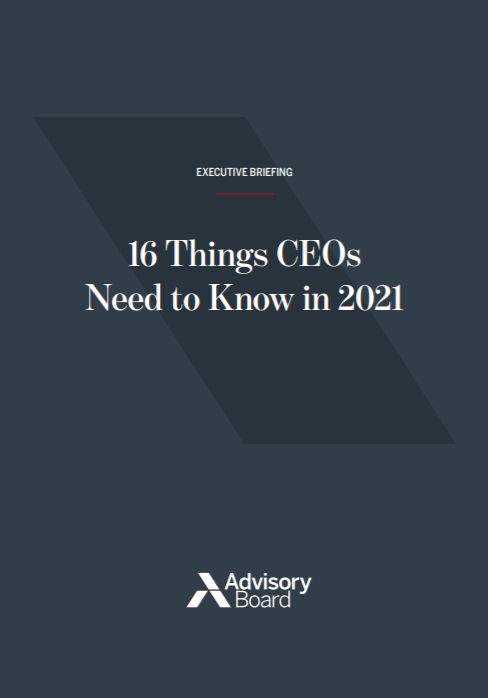
This executive briefing examines the emerging focus on resilience by breaking down how purchaser motivations are (and aren’t) shifting—and how the core structural elements of the delivery system must evolve as a result of the Covid-19 pandemic.
Learn the top 16 insights about the state of the health care industry in the wake of the Covid-19 pandemic.
Don't miss out on the latest Advisory Board insights
Create your free account to access 1 resource, including the latest research and webinars.
Want access without creating an account?
You have 1 free members-only resource remaining this month.
1 free members-only resources remaining
1 free members-only resources remaining
You've reached your limit of free insights
Become a member to access all of Advisory Board's resources, events, and experts
Never miss out on the latest innovative health care content tailored to you.
Benefits include:
You've reached your limit of free insights
Become a member to access all of Advisory Board's resources, events, and experts
Never miss out on the latest innovative health care content tailored to you.
Benefits include:
This content is available through your Curated Research partnership with Advisory Board. Click on ‘view this resource’ to read the full piece
Email ask@advisory.com to learn more
Click on ‘Become a Member’ to learn about the benefits of a Full-Access partnership with Advisory Board
Never miss out on the latest innovative health care content tailored to you.
Benefits Include:
This is for members only. Learn more.
Click on ‘Become a Member’ to learn about the benefits of a Full-Access partnership with Advisory Board
Never miss out on the latest innovative health care content tailored to you.
